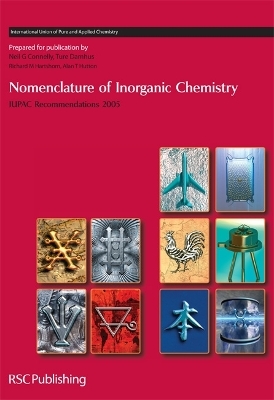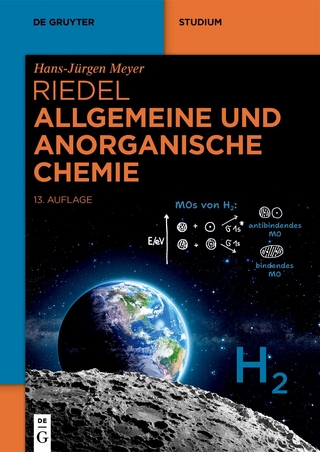
Nomenclature of Inorganic Chemistry
Royal Society of Chemistry (Verlag)
978-0-85404-438-2 (ISBN)
The Rules of Inorganic Nomenclature (the 'Red Book'), first published in 1958 by the International Union of Pure and Applied Chemistry (IUPAC), was most recently updated as Nomenclature of Inorganic Chemistry 1990. This new edition of the Red Book clarifies and updates recommendations concerning the names and formulae of inorganic compounds and reflects major recent developments in inorganic chemistry. Moreover, it presents recommendations fully consistent with the principles of the nomenclature of organic chemistry. In order to choose the most appropriate of the various nomenclature systems described, a flowchart is provided to guide the reader to a section or chapter where rules can be found for a particular type of compound or species. Copious examples are supplemented by an extensive subject index. Nomenclature of Inorganic Chemistry: Recommendations 2005 is the definitive guide for scientists working in academia or industry, for scientific publishers of books, journals and databases, and for organisations requiring internationally approved nomenclature in a legal or regulatory environment.
1: General Aims, Functions and Methods of Chemical Nomenclature;
1.1: Introduction;
1.2: History of chemical nomenclature;
1.3: Aims of chemical nomenclature;
1.4: Functions of chemical nomenclature;
1.5: Methods of inorganic nomenclature;
1.6: Changes to previous IUPAC recommendations;
1.7: Nomenclature recommendations in other areas of chemistry;
1.8: References;
2: Grammar;
2.1: Introduction;
2.2: Enclosing marks;
2.3:Hyphens, plus and minus signs, 'em' dashes and bond indicators;
2.4: Solidus;
2.5: Dots, colons, commas and semicolons;
2.6: Spaces;
2.7: Elisions;
2.8: Numerals;
2.9: Italic letters;
2.10: Greek alphabet;
2.11: Asterisks;
2.12: Primes;
2.13: Multiplicative prefixes;
2.14: Locants;
2.15: Ordering principles;
2.16: Final remarks;
2.17: References;
3: Elements;3.1: Names and symbols of atoms;
3.2: Indication of mass, charge and atomic number using indexes (subscripts and superscripts);
3.3: Isotopes;
3.4: Elements (or elementary substances);
3.5: Elements in the periodic table;
3.6: References;
4: Formulae;
4.1: Introduction;
4.2: Definitions of types of formula;
4.3: Indication of ionic charge;
4.4: Sequence of citation of symbols in formulae;
4.5: Isotopically modified compounds;
4.6: Optional modifiers of formulae;
4.7: References;
5: Compositional Nomenclature, and Overview of Names of Ions and Radicals;
5.1: Introduction;
5.2: Stoichiometric names of elements and binary compounds;
5.3: Names of ions and radicals;
5.4: Generalized stoichiometric names;
5.5: Names of (formal) addition compounds;
5.6: Summary;
5.7: References;
6: Parenthydride Names and Substitutive Nomenclature;
6.1: Introduction;
6.2: Parent hydride names;
6.3: Substitutive names of derivatives of parent hydrides;
6.4: Names of ions and radicals derived from parent hydrides;
6.5: References;
7: Additive Nomenclature;
7.1: Introduction;
7.2: Mononuclear entities;
7.3: Polynuclear entities;
7.4: Inorganic chains and rings;
7.5: References;
8: Inorganic Acids and Derivatives;
8.1: Introduction and overview;
8.2: General principles for systematic naming of acids;
8.3: Additive names;
8.4: Hydrogen names;
8.5: Abbreviated hydrogen names for certain anions;
8.6: Functional replacement names for derivatives of oxoacids;
8.7: References;
9: Coordination Compounds;
9.1: Introduction;
9.2: Describing the constitution of coordination compounds;
9.3: Describing the configuration of coordination entities;
9.4: Final remarks;
9.5: References;
10: Organometallic Compounds;
10.1: Introduction;
10.2: Nomenclature of organometallic compounds of the transition elements;
10.3: Nomenclature of organometallic compounds of the main group elements;
10.4: Ordering of central atoms in polynuclear organometallic Compounds;
10.5: References;
11: Solids;
11.1: Introduction;
11.2: Names of solid phases;
11.3: Chemical composition;
11.4: Point defect (Kroeger-Vink) notation;
11.5: Phase nomenclature;
11.6: Non-stoichiometric phases;
11.7: Polymorphism;
11.8: Final remarks;
11.9: References;
Tables;
Table I: Names, symbols and atomic numbers of the elements;
Table II: Temporary names and symbols for elements of atomic number greater Than 111;
Table III: Suffixes and endings;
Table IV: Multiplicative prefixes;
Table V: Geometrical and structural affixes;
Table VI: Element sequence;
Table VII: Ligand abbreviations;
Table VIII: Structural formulae of selected ligands;
Table IX: Names of homoatomic, binary and certain other simple molecules, ions, compounds, radicals and substituent groups;
Table X: Anion names, 'a' terms used in substitutive nomenclature and 'y' terms used in chains and rings nomenclature
| Erscheint lt. Verlag | 22.11.2005 |
|---|---|
| Verlagsort | Cambridge |
| Sprache | englisch |
| Maße | 276 x 219 mm |
| Gewicht | 1143 g |
| Themenwelt | Naturwissenschaften ► Chemie ► Anorganische Chemie |
| ISBN-10 | 0-85404-438-8 / 0854044388 |
| ISBN-13 | 978-0-85404-438-2 / 9780854044382 |
| Zustand | Neuware |
| Informationen gemäß Produktsicherheitsverordnung (GPSR) | |
| Haben Sie eine Frage zum Produkt? |
aus dem Bereich


